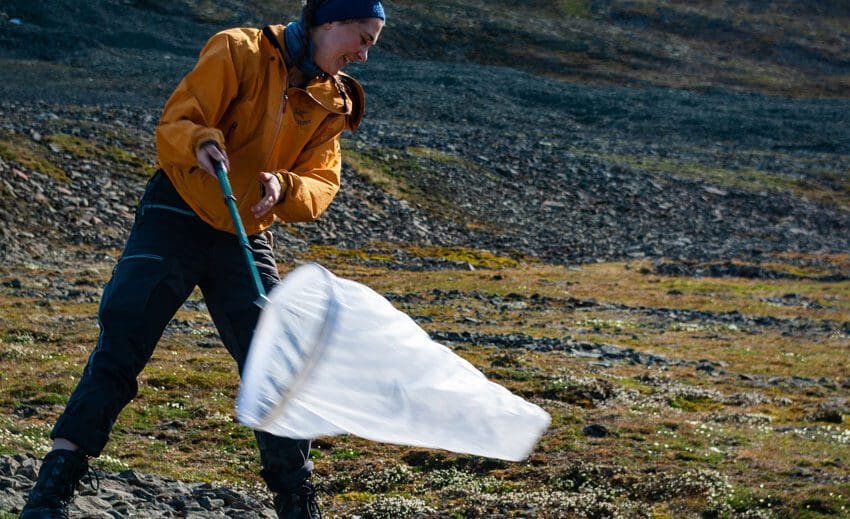Flower love in Bjørndalen
What are those weird things in Bjørndalen? The Arctic Biology Department at UNIS has co-located many research and education projects in Bjørndalen with the aim of building a "field laboratory". The idea is that co-location of research projects gives less environmental footprint, increased collaboration, and the opportunity to put data sets together to understand larger relationships in nature. Among other things, we study the interaction between insects and flowers.

Rebekka Ween hunts pollinating insects with a sweep net. Photo: Simen Hjelle
Text: Pernille Bronken Eidesen, Anne Bruls, Simen Hjelle and Rebekka Ween, UNIS.
Being able to reproduce oneself is the very definition of life – and that is what flowering is all about. But the Arctic summer is short. For an Arctic flower, it is important to act quickly. This is especially true for flowers that rely on insects for efficient pollination. During a short summer, they must be able to produce flowers that attract pollinating insects, mature seeds, and disperse them before winter sets in. Colourful, fragrant Arctic flowers are really advertising signs for insects that say, “Food and shelter for the weather, come in, come in”. For the flowers, the goal of the investment is to exchange pollen grains with other flowers of the same species.

This system requires good timing. Flowering should occur as early as possible, but not until the right pollinators are active and ready to work. This timing is governed by, among other things, light conditions, the species’ biological clock and climatic conditions. But the climate in Svalbard is changing. It gets hotter and the cold days get fewer. Rapid climate change can have major consequences for the interaction between flowers and pollinating insects.
We want to understand this interaction better and how it is affected by climatic changes. What is most important for successful reproduction of these Arctic flowers? Is it which insects that are present to do the job, at what time it is carried out, or are the climatic conditions crucial?

To answer these questions, we monitor various types of flowers using time-lapse cameras in Bjørndalen. These cameras take pictures every minute, making it possible to monitor flower development, insect visitation and seed production over time. We also make experiments where we look at what happens when we shut out the pollinators. If you see plants in Bjørndalen with nylon socks on, these are plants we have put in “celibacy” so to speak. And then we scientists play the pollinators and choose who to pollinate and not.
In addition, we catch insects in traps that are emptied each week to identify possible pollinators. In Svalbard, it is mainly mosquitoes and flies that are responsible for the pollination work. More efficient pollinators, such as bumblebees and bees, do not live here. Therefore, we also compare the data from Svalbard with similar data from other localities that have different, more efficient pollinators and a different climate.
We have planned data collection over three years to account for seasonal variation. This is the second summer we collect this data, and next summer we hope to be able to answer who does the pollination job, when it is done and what climatic factors are involved. You can read more about the project here: Automated monitoring to study plant phenology (PDF)
Download the ArtsApp
Did you know that you can download an app to identify plant species in Svalbard? Through support and collaboration with the ArtsApp project, svalbardflora.no, bioCEED and the Svalbard Environmental Protection Fund, students and staff at UNIS are working to create an app for identifying plants on Svalbard. This is still work in progress, but we would like feedback on what works and does not work along the way. Search for ArtsApp, download and test. Feel free to contact us if you want to be part of our test panel (pernillee@unis.no).
